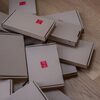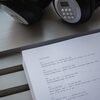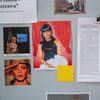A THREE-PART EXHIBITION AT THE GOETHE-INSTITUT IRLAND'S RETURN GALLERY CURATED BY ART IN THE CONTEMPORARY WORLD (ACW).
RE/MAINS OF THE DAZE: an exhibition in three courses is the culmination of research into three historical exhibitions: Lucy Lippard’s ‘Numbers’ shows (1969-1974), Jean-François Lyotard and Thierry Chaput's Les Immatériaux (1985) and Okwui Enwezor’s The Short Century: Independence and Liberation Movements in Africa, 1945–1994 (2001-2002).
Each exhibition occupies a moment in the history of art as a disruption to the modernist construct of the exhibition. Lippard reimagined the dichotomy between artist and curator and took the exhibition beyond the walls of the museum. Lyotard and Chaput troubled the idea of the singular subjective experience and materialised the de-centered and fragmented condition of postmodernity. Enwezor challenged Eurocentric museum spaces and exhibited African art in relation to independence and liberation movements of the 20th century.
The show at the Goethe-Institut presents three speculative projects designed by ACW’s incoming 2021 postgraduate cohort, each sharing the task of viewing a past exhibition through archival documents.
RE/MAINS OF THE DAZE: an exhibition in three courses plays on the idea of the ‘remains’ of modernism filtered through the ‘daze’ of postmodernism, a self-referential fugue state that endures through historical habits.
RE/MAINS OF THE DAZE: an exhibition in three courses is presented by the Goethe-Institut Irland in collaboration with the National College of Art and Design in Dublin. ACW is the theory/practice MA/MFA in the School of Visual Culture at the NCAD.
THE THREE COURSES
c. 200
by Leila Anglade, Alison Lowry, Alex Pentek, Belinda Quirke
 Ste Murray
c. 200
Ste Murray
c. 200 presents a response to Lucy Lippard’s series of ‘Numbers’ exhibitions between 1969 and 1974, in the Goethe-Institut Irland’s Return Gallery and various locations in Dublin. Lippard’s '2,972,453' exhibition (1971) used suitcases to transport the artworks and assembly instructions to
Centro de Arte y Comunicación in Buenos Aires, Argentina. The idea of an exhibition in a suitcase underpins the ‘dematerialized’ and easily deployable approach to curating
c. 200.
In the Return Gallery, 200 cardboard boxes are architecturally stacked and deliberately toppled to represent the number of cultural institutions and galleries in Ireland that have been closed due to the Covid-19 pandemic, like the ruins of some unknown venture. Two adboxes near the gallery display parts of
c. 200 ‘outside of the frame’. In addition, images of the cardboard boxes with iconic red ‘Closed to Public’ stickers have been photographed throughout Ireland outside closed art institutions.
The ‘catalogue’ for
c. 200 presents a series of unbound index cards with selections of handwritten quotations from Lippard and others, a typed essay, photographs, hand drawn maps and other materials related to the ‘Numbers’ exhibitions.
c. 200 can be viewed on acw.ie and adbox locations near the Goethe-Institut Irland
NOUVEAUX IMMATÉRIAUX
by Nadia J. Armstrong, Tom Creed, Catherine Fay, Anna Maye, Katharina Steins
 Ste Murray
In 1985 philosopher Jean-François Lyotard and curator Thierry Chaput developed Les Immatériaux at Centre Pompidou. Covering the entirety of the newly founded museum’s fifth floor, the exhibition was split into 31 zones, each of which dealt with a different aspect of postmodern life. In developing their response to Les Immatériaux, the NOUVEAUX IMMATÉRIAUX team reflected on the questions: "What is the materiality of today’s world, and is there a graspable aspect to our information society?"
Ste Murray
In 1985 philosopher Jean-François Lyotard and curator Thierry Chaput developed Les Immatériaux at Centre Pompidou. Covering the entirety of the newly founded museum’s fifth floor, the exhibition was split into 31 zones, each of which dealt with a different aspect of postmodern life. In developing their response to Les Immatériaux, the NOUVEAUX IMMATÉRIAUX team reflected on the questions: "What is the materiality of today’s world, and is there a graspable aspect to our information society?"
NOUVEAUX IMMATÉRIAUX translates the mediation strategies from Les Immatériaux by using a combination of found and original audio material to explore the im/materialities of the 21st century. The resulting experimental acoustic symposium draws on several months of studying original materials from the 1985 exhibition and conducting linguistic experiments on themes immanent in technologies of then and now. Where the original audio featured predominantly white male speakers, this new response gives priority to female, queer, and non-Western voices.
Alongside the audio guide, the exhibition includes a transcription of a discussion between the NOUVEAUX IMMATÉRIAUX team members on their exhibition's contents, contexts and process, created using speech-to text technology.
After the Century
by Simon Bhuiyan, Brian Cooney, Kristen Olson, Aisling-Ór Ní Aodha
 Ste Murray
After the Century
Ste Murray
After the Century focuses on research conducted around
The Short Century exhibition by Okwui Enwezor. The presentation displays the multiplicity of African modernism in a mix of mediums and methods, echoing Enwezor’s approach in his 2001 and 2002 shows.
Installed in the Return Gallery’s south wall,
After the Century consists of collaged images, quotes, texts and other findings that emerge as the group’s mediation on
The Short Century. It aims to inhabit the multiplicity of African modernism that Enwezor invested his research in, as well as point to the present moment of contemporary art on the continent. A web-like graph displays the multi-faceted method of
The Short Century, spanning the 59 artists involved, their 22 countries of origin and the partial colonial history of each country. Both ‘formal’ and ‘informal’ display methods are used, from vinyl posters to sticky notes, masking tape, handwritten notes and printed documents.
The group’s frequent conversations around related questions of Irish post colonialism/imperialism is presented in a fictionalized brochure that imagines events that could have taken place alongside
The Short Century had it travelled to Ireland.
Return Gallery opening times
Monday-Friday: 12 noon - 5.30 pm
Due to ongoing Covid-related restrictions, the Goethe-Institut Irland is currently open to the public to a limited extent. The exhibition can be visited by up to 2 people at a time. Approx. visiting time 30-45 minutes. No booking required.
Please note that due to the protected structure of the Georgian building, the gallery is not wheelchair accessible.
Back